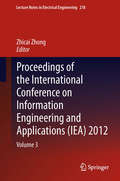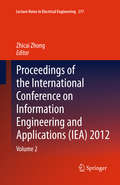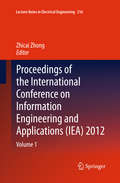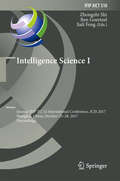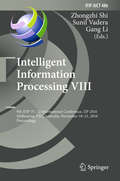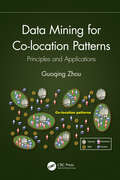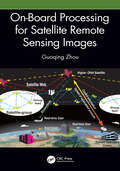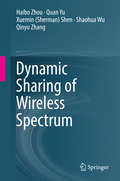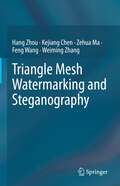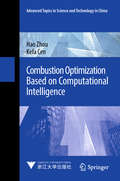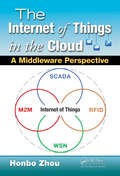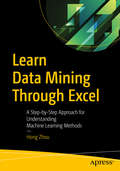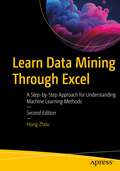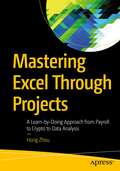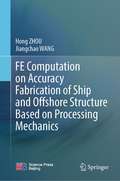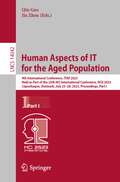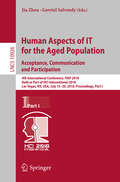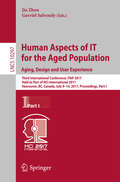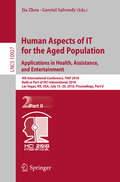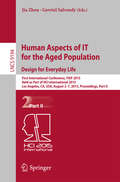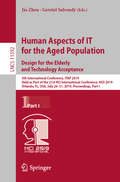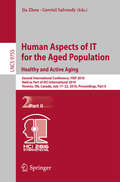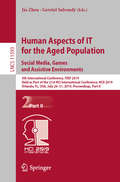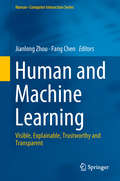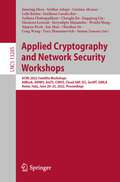- Table View
- List View
Proceedings of the International Conference on Information Engineering and Applications (IEA) 2012: 218
by Zhicai ZhongInformation engineering and applications is the field of study concerned with constructing information computing, intelligent systems, mathematical models, numerical solution techniques, and using computers and other electronic devices to analyze and solve natural scientific, social scientific and engineering problems. <P><P> Information engineering is an important underpinning for techniques used in information and computational science and there are many unresolved problems worth studying. The Proceedings of the 2nd International Conference on Information Engineering and Applications (IEA 2012), which was held in Chongqing, China, from October 26-28, 2012, discusses the most innovative research and developments including technical challenges and social, legal, political, and economic issues.<P> A forum for engineers and scientists in academia, industry, and government, the Proceedings of the 2nd International Conference on Information Engineering and Applications presents ideas, results, works in progress, and experience in all aspects of information engineering and applications.
Proceedings of the International Conference on Information Engineering and Applications (IEA) 2012: 217
by Zhicai ZhongInformation engineering and applications is the field of study concerned with constructing information computing, intelligent systems, mathematical models, numerical solution techniques, and using computers and other electronic devices to analyze and solve natural scientific, social scientific and engineering problems. <P><P> Information engineering is an important underpinning for techniques used in information and computational science and there are many unresolved problems worth studying. The Proceedings of the 2nd International Conference on Information Engineering and Applications (IEA 2012), which was held in Chongqing, China, from October 26-28, 2012, discusses the most innovative research and developments including technical challenges and social, legal, political, and economic issues.<P> A forum for engineers and scientists in academia, industry, and government, the Proceedings of the 2nd International Conference on Information Engineering and Applications presents ideas, results, works in progress, and experience in all aspects of information engineering and applications.
Proceedings of the International Conference on Information Engineering and Applications (IEA) 2012: Volume 1
by Zhicai ZhongInformation engineering and applications is the field of study concerned with constructing information computing, intelligent systems, mathematical models, numerical solution techniques, and using computers and other electronic devices to analyze and solve natural scientific, social scientific and engineering problems. <P><P> Information engineering is an important underpinning for techniques used in information and computational science and there are many unresolved problems worth studying. The Proceedings of the 2nd International Conference on Information Engineering and Applications (IEA 2012), which was held in Chongqing, China, from October 26-28, 2012, discusses the most innovative research and developments including technical challenges and social, legal, political, and economic issues.<P> A forum for engineers and scientists in academia, industry, and government, the Proceedings of the 2nd International Conference on Information Engineering and Applications presents ideas, results, works in progress, and experience in all aspects of information engineering and applications.
Intelligence Science I: Second IFIP TC 12 International Conference, ICIS 2017, Shanghai, China, October 25-28, 2017, Proceedings (IFIP Advances in Information and Communication Technology #510)
by Zhongzhi Shi, Ben Goertzel and Jiali FengThis book constitutes the refereed proceedings of the Second International Conference on Intelligence Science, ICIS 2017, held in Shanghai, China, in October 2017.The 38 full papers and 9 short papers presented were carefully reviewed and selected from 82 submissions. They deal with key issues in intelligence science and have been organized in the following topical sections: theory of intelligence science; cognitive computing; big data analysis and machine learning; machine perception; intelligent information processing; and intelligent applications.
Intelligent Information Processing VIII: 9th IFIP TC 12 International Conference, IIP 2016, Melbourne, VIC, Australia, November 18-21, 2016, Proceedings (IFIP Advances in Information and Communication Technology #486)
by Zhongzhi Shi, Sunil Vadera and Gang LiThis book constitutes the refereed proceedings of the 9th IFIP TC 12 International Conference on Intelligent Information Processing, IIP 2016, held in Melbourne, VIC, Australia, in October 2016. The 24 full papers and 3 short papers presented were carefully reviewed and selected from more than 40 submissions. They are organized in topical sections on machine learning, data mining, deep learning, social computing, semantic web and text processing, image understanding, and brain-machine collaboration.
Data Mining for Co-location Patterns: Principles and Applications
by Guoqing ZhouCo-location pattern mining detects sets of features frequently located in close proximity to each other. This book focuses on data mining for co-location pattern, a valid method for identifying patterns from all types of data and applying them in business intelligence and analytics. It explains the fundamentals of co-location pattern mining, co-location decision tree, and maximal instance co-location pattern mining along with an in-depth overview of data mining, machine learning, and statistics. This arrangement of chapters helps readers understand the methods of co-location pattern mining step-by-step and their applications in pavement management, image classification, geospatial buffer analysis, etc.
On-Board Processing for Satellite Remote Sensing Images
by Guoqing ZhouOn-board image processing systems are used to maximize image data transmission efficiency for large volumes of data gathered by Earth observation satellites. This book explains the methods, mathematical models, and key technologies used for these systems. It introduces the background, basic concepts, and the architecture of on-board image processing, along with on-board detection of the image feature and matching, ground control point identification, on-board geometric correction, calibration, geographic registration, etc. • Describes algorithms and methodologies for on-board image processing with FPGA chips. • Migrates the traditional on-ground computing to on-board operation and the image processing is implemented on-board, not on-ground. • Introduces for the first time many key technologies and methods for on-board image processing. • Emphasizes the recent progress in image processing by using on-board FPGA chips. • Includes case studies from the author’s extensive research and experience on the topic. This book gives insights into emerging technologies for on-board processing and will benefit senior undergraduate and graduate students of remote sensing, information technology, computer science and engineering, electronic engineering, and geography, as well as researchers and professionals interested in satellite remote sensing image processing in academia, and governmental and commercial sectors.
Dynamic Sharing of Wireless Spectrum
by Haibo Zhou Quan Yu Xuemin Sherman Shen Shaohua Wu Qinyu ZhangThis book focuses on the current research on the dynamic spectrum sharing for efficient spectrum resource utilization, which covers the overlay spectrum sharing, underlay spectrum sharing and database-assisted spectrum sharing related research issues. Followed by a comprehensive review and in-depth discussion of the current state-of-the-art research literature and industry standardization, this book first presents a novel overlay spectrum sharing framework for dynamic utilization of available cellular frequency bands, formulates the dynamic spectrum sharing problem as a dynamic resource demand-supply matching problem, and accordingly develops a distributed fast spectrum sharing algorithm to solve the resource matching problem. A self-awareness power control approach for multi-hop routing selection is proposed, which can establish an effective and practical routing selection optimization in secondary access networks and minimize the interference to primary users. Finally, this book offers dynamic secondary access scheme for database-assisted spectrum sharing networks, which is targeted to support the prosperous wireless multimedia networking applications by leveraging the TV white spaces of geolocation databases while satisfying QoS guarantees of secondary users. The overlay spectrum sharing, underlay spectrum sharing, and database-assisted white spaces spectrum sharing research results that are presented in this book provide useful insights for the design of next generation wireless access networks. This book motivates a new line of thinking for efficient spectrum resource utilization and performance enhancements of future wireless access applications.
Triangle Mesh Watermarking and Steganography
by Hang Zhou Kejiang Chen Zehua Ma Feng Wang Weiming ZhangThis book provides a systematic overview of watermarking and steganography methods for triangle meshes related to computer graphics and security. The significance of this research has been well recognized by the growing body of work on watermarking, steganography and steganalysis of 3D meshes. With the evolution of the CAD industry and real-world end-user applications such as virtual reality (VR) and 3D printing, 3D meshes have attracted world-wide attention. Besides, the flexible data structure of 3D geometry provides enough space to embed secret information, making it ideal for applications such as copyright protection and covert communication. Our goal of the book is to allow readers to systematically understand 3D mesh information hiding technology and its applications as a whole. The book outlines comprehensive techniques, including handcrafted and deep learning-based techniques, digital and physical techniques in the literature and provides standard evaluation metrics for triangle meshes. The up-to-date geometrical deep learning and 3D printing-related algorithms are also covered. Offering a rich blend of ideas and algorithms, the book is up-to-date and self-contained. It is an excellent reference resource for users who are seeking 3D mesh watermarking and steganography algorithms, as well as for graduate students and researchers wanting to grasp the frontiers of triangular mesh processing on data hiding.
Combustion Optimization Based on Computational Intelligence (Advanced Topics in Science and Technology in China)
by Hao Zhou Kefa CenThis book presents the latest findings on the subject of combustion optimization based on computational intelligence. It covers a broad range of topics, including the modeling of coal combustion characteristics based on artificial neural networks and support vector machines. It also describes the optimization of combustion parameters using genetic algorithms or ant colony algorithms, an online coal optimization system, etc. Accordingly, the book offers a unique guide for researchers in the areas of combustion optimization, NOx emission control, energy and power engineering, and chemical engineering.
The Internet of Things in the Cloud: A Middleware Perspective
by Honbo ZhouAlthough the Internet of Things (IoT) is a vast and dynamic territory that is evolving rapidly, there has been a need for a book that offers a holistic view of the technologies and applications of the entire IoT spectrum. Filling this void, The Internet of Things in the Cloud: A Middleware Perspective provides a comprehensive introduction to the Io
Learn Data Mining Through Excel: A Step-by-Step Approach for Understanding Machine Learning Methods
by Hong ZhouUse popular data mining techniques in Microsoft Excel to better understand machine learning methods.Software tools and programming language packages take data input and deliver data mining results directly, presenting no insight on working mechanics and creating a chasm between input and output. This is where Excel can help.Excel allows you to work with data in a transparent manner. When you open an Excel file, data is visible immediately and you can work with it directly. Intermediate results can be examined while you are conducting your mining task, offering a deeper understanding of how data is manipulated and results are obtained. These are critical aspects of the model construction process that are hidden in software tools and programming language packages.This book teaches you data mining through Excel. You will learn how Excel has an advantage in data mining when the data sets are not too large. It can give you a visual representation of data mining, building confidence in your results. You will go through every step manually, which offers not only an active learning experience, but teaches you how the mining process works and how to find the internal hidden patterns inside the data.What You Will LearnComprehend data mining using a visual step-by-step approachBuild on a theoretical introduction of a data mining method, followed by an Excel implementationUnveil the mystery behind machine learning algorithms, making a complex topic accessible to everyoneBecome skilled in creative uses of Excel formulas and functionsObtain hands-on experience with data mining and ExcelWho This Book Is ForAnyone who is interested in learning data mining or machine learning, especially data science visual learners and people skilled in Excel, who would like to explore data science topics and/or expand their Excel skills. A basic or beginner level understanding of Excel is recommended.
Learn Data Mining Through Excel: A Step-by-Step Approach for Understanding Machine Learning Methods
by Hong ZhouUse popular data mining techniques in Microsoft Excel to better understand machine learning methods. Most software tools and programming language packages take data input and deliver data mining results directly, presenting no insight on working mechanics and creating a chasm between input and output. This is where Excel can help, and this book will show you exactly how. This updated edition demonstrates how to work with data in a transparent manner using Excel. When you open an Excel file, data is visible immediately and you can work with it directly. You’ll see how to examine intermediate results even as you are still conducting your mining task, offering a deeper understanding of how data is manipulated, and results are obtained. These are critical aspects of the model construction process that are often hidden in software tools and programming language packages. Over the course of Learn Data Mining Through Excel, you will learn the data mining advantages the application offers when the data sets are not too large. You’ll see how to use Excel’s built-in features to create visual representations of your data, enabling you to present your findings in an accessible format. Author Hong Zhou walks you through each step, offering not only an active learning experience, but teaching you how the mining process works and how to find hidden patterns within the data. Upon completing this book, you will have a thorough understanding of how to use an application you very likely already have to mine and analyze data, and how to present results in various formats. What You Will Learn Comprehend data mining using a visual step-by-step approachGain an introduction to the fundamentals of data miningImplement data mining methods in ExcelUnderstand machine learning algorithmsLeverage Excel formulas and functions creativelyObtain hands-on experience with data mining and Excel Who This Book Is For Anyone who is interested in learning data mining or machine learning, especially data science visual learners and people skilled in Excel who would like to explore data science topics and/or expand their Excel skills. A basic or beginner level understanding of Excel is recommended.
Mastering Excel Through Projects: A Learn-by-Doing Approach from Payroll to Crypto to Data Analysis
by Hong ZhouMaster Excel in less than two weeks with this unique project-based book! Let’s face it, we all master skills in our own way, but building a soup-to-nuts project is one of the best ways to make learning stick and get up to speed quickly. Whether you are just getting started with Excel or are an experienced user, this book will elevate your knowledge and skills. For a beginner, the micro examples in each chapter will warm you up before you dive into the projects. For experienced users, the projects, especially those with table setup considerations, will help you become more creative in your interactions with Excel. Readers will benefit from building eight unique projects, each covering a different topic, including a word game, a food nutrition ranking, a payroll (tax withholding) calculation, an encryption, a two-way table, a Kaplan-Meier analysis, a data analysis via a pivot table and the K-means Clustering data mining method. Through these projects, you will experience firsthand how Excel skills are organized together to accomplish tasks that sound complex and daunting when first described. Get started with a word game which asks users to find English words that amount to exactly 100 points, with each letter of the alphabet assigned a point 1, 2, 3, … 26, respectively. You will disassemble a word into letters and then sum up their points, and then take it one step further, contemplating how to make the completed Excel worksheet more user friendly and completely automated. Increasingly challenging tasks like this example build on what you have learned and increase your confidence along the way, ensuring your mastery of Excel. What You Will Learn Gain confidence to tackle a challenging Excel-related mission, even those that seem impossibleBecome skilled in the creative uses of Excel formulas and functions and other built-in features Appreciate the art of refining worksheets to maximize automationUnderstand the value of treating each worksheet as a unique product Who This Book Is ForPeople who are interested in learning Excel as quickly and efficiently as possible. While Excel beginners and intermediate users are the primary audience, experienced Excel users might also discover new skills and ways of working with Excel.
FE Computation on Accuracy Fabrication of Ship and Offshore Structure Based on Processing Mechanics
by Hong ZHOU Jiangchao WANGThis book provides insight on processing mechanics during ship and offshore structure, and researchers, scientists, and engineers in the field of manufacturing process mechanics can benefit from the book. This book is written by subject experts based on the recent research results in FE computation on accuracy fabrication of ship and offshore structures based on processing mechanics. In order to deal with actual engineering problems during construction of ship and offshore structure, it proposes advanced computational approaches such as thermal elastic–plastic and elastic FE computations and employed to examine physical behavior and clarifies generation mechanism of mechanical response. As such, this book provides valuable knowledge, useful methods, and practical algorithms that can be considered in manufacturing process mechanics.
Human Aspects of IT for the Aged Population: 9th International Conference, ITAP 2023, Held as Part of the 25th HCI International Conference, HCII 2023, Copenhagen, Denmark, July 23–28, 2023, Proceedings, Part I (Lecture Notes in Computer Science #14042)
by Jia Zhou Qin GaoThis two-volume set of ITAP 2023, constitutes the refereed proceedings of the 9th International Conference on Human Aspects of IT for the Aged Population, ITAP 2023, held as Part of the 24th International Conference, HCI International 2023, which took place in July 2023 in Copenhagen, Denmark.The total of 1578 papers and 396 posters included in the HCII 2023 proceedings volumes was carefully reviewed and selected from 7472 submissions. The papers of ITAP 2023 Part I are organized in topical sections named: Designing and Assessing the Older Users' Experience; Aging and Social Media; Voice Assistants and Chatbots; Games and Exergames for Older People.
Human Aspects of IT for the Aged Population. Acceptance, Communication and Participation: 4th International Conference, ITAP 2018, Held as Part of HCI International 2018, Las Vegas, NV, USA, July 15–20, 2018, Proceedings, Part I (Lecture Notes in Computer Science #10926)
by Jia Zhou Gavriel SalvendyThis book constitutes the proceedings of the 4th International Conference onHuman Aspects of IT for the Aged Population, ITAP 2018, held as part of the 20th International Conference, HCI International 2018, which took place in Las Vegas, Nevada, in July 2018.The total of 1171 papers and 160 posters included in the 30 HCII 2018 proceedings volumes was carefully reviewed and selected from 4346 submissions. ITAP 2018 includes a total of 84 papers. They were organized in topical sections as follows: Part I: aging and technology acceptance; aging and interaction; intergenerational communication and social participation. Part II: health care technologies and services for the elderly; intelligent environments for aging; and games and entertainment for the elderly.
Human Aspects of IT for the Aged Population. Aging, Design and User Experience
by Jia Zhou Gavriel SalvendyThe two-volume set LNCS 10297 + 10298 constitutes the refereed proceedings of the Third International Conference on Human Aspects of IT for the Aged Population, ITAP 2017, held as part of HCI International 2017 in Vancouver, BC, Canada. HCII 2017 received a total of 4340 submissions, of which 1228 papers were accepted for publication after a careful reviewing process. The 83 papers presented in the two volumes of ITAP 2017 were organized in topical sections as follows: Part I: aging and technology acceptance; user-centred design for the elderly; product design for the elderly; aging and user experience; digital literacy and training. Part II: mobile and wearable interaction for the elderly; aging and social media; silver and intergenerational gaming; health care and assistive technologies and services for the elderly; aging and learning, working and leisure.
Human Aspects of IT for the Aged Population. Applications in Health, Assistance, and Entertainment: 4th International Conference, ITAP 2018, Held as Part of HCI International 2018, Las Vegas, NV, USA, July 15–20, 2018, Proceedings, Part II (Lecture Notes in Computer Science #10927)
by Jia Zhou Gavriel SalvendyThis book constitutes the proceedings of the 4th International Conference onHuman Aspects of IT for the Aged Population, ITAP 2018, held as part of the 20th International Conference, HCI International 2018, which took place in Las Vegas, Nevada, in July 2018. The total of 1171 papers and 160 posters included in the 30 HCII 2018 proceedings volumes was carefully reviewed and selected from 4346 submissions. ITAP 2018 includes a total of 84 papers. They were organized in topical sections as follows: Part I: aging and technology acceptance; aging and interaction; intergenerational communication and social participation. Part II: health care technologies and services for the elderly; intelligent environments for aging; and games and entertainment for the elderly.
Human Aspects of IT for the Aged Population. Design for Everyday Life
by Jia Zhou Gavriel SalvendyThe two LNCS volume set 9193-9194 constitutes the refereed proceedings of the First International Conference on Human Aspects of IT for the Aged Population, ITAP 2015, held as part of the 17th International Conference on Human-Computer Interaction, HCII 2015, held in Los Angeles, CA, USA, in August 2015, jointly with 15 other thematically conferences. The total of 1462 papers and 246 posters presented at the HCII 2015 conferences were carefully reviewed and selected from 4843 submissions. These papers of the two volume set address as follows: LNCS 9193, Design for Aging (Part I), addressing the following major topics: HCI design and evaluation methods for the elderly; ICT use and acceptance; aging, the web and social media; and the elderly and mobile devices and LNCS 9194, Design for Everyday Life (Part II), addressing the following major topics: health care technologies and services for the elderly; home and work support; smart environment and AAL; and communication, games, and entertainment.
Human Aspects of IT for the Aged Population. Design for the Elderly and Technology Acceptance: 5th International Conference, ITAP 2019, Held as Part of the 21st HCI International Conference, HCII 2019, Orlando, FL, USA, July 26-31, 2019, Proceedings, Part I (Lecture Notes in Computer Science #11592)
by Jia Zhou Gavriel SalvendyThis two-volume set LNCS 11592 and 11593 constitutes the refereed proceedings of the 5th International Conference on Human Aspects of IT for the Aged Population, ITAP 2019, held in July 2019 as part of HCI International 2019 in Orlando, FL, USA. HCII 2019 received a total of 5029 submissions, of which 1275 papers and 209 posters were accepted for publication after a careful reviewing process. The 86 papers presented in these two volumes are organized in topical sections named: Design with and for the Elderly, Aging and Technology Acceptance, Aging and the User Experience, Elderly-Specific Web Design, Aging and Social Media, Games and Exergames for the Elderly, Ambient Assisted Living, Aging, Motion, Cognition, Emotion and Learning.
Human Aspects of IT for the Aged Population. Healthy and Active Aging
by Jia Zhou Gavriel SalvendyThe two LNCS volume set 9754-9755 constitutes the refereed proceedings of the Second International Conference on Human Aspects of IT for the Aged Population, ITAP 2016, held as part of the 18th International Conference on Human-Computer Interaction, HCII 2016, held in Toronto, ON, Canada, in July 2016, jointly with 14 other thematically conferences. The total of 1287 papers presented at the HCII 2016 conferences were carefully reviewed and selected from 4354 submissions. LNCS 9754, Design for Aging (Part I), addresses the following major topics: designing for and with the elderly; technology use and acceptance by older users; psychological and cognitive aspects of interaction and aging; and mobile and wearable technologies for the elderly. LNCS 9755, Healthy and Active Aging (Part II), addresses these major topics: smart and assistive environments; aging and social media; aging, learning, training and games; and aging, mobility and driving.
Human Aspects of IT for the Aged Population. Social Media, Games and Assistive Environments: 5th International Conference, ITAP 2019, Held as Part of the 21st HCI International Conference, HCII 2019, Orlando, FL, USA, July 26-31, 2019, Proceedings, Part II (Lecture Notes in Computer Science #11593)
by Jia Zhou Gavriel SalvendyThis two-volume set LNCS 11592 and 11593 constitutes the refereed proceedings of the 5th International Conference on Human Aspects of IT for the Aged Population, ITAP 2019, held in July 2019 as part of HCI International 2019 in Orlando, FL, USA. HCII 2019 received a total of 5029 submissions, of which 1275 papers and 209 posters were accepted for publication after a careful reviewing process. The 86 papers presented in these two volumes are organized in topical sections named: Design with and for the Elderly, Aging and Technology Acceptance, Aging and the User Experience, Elderly-Specific Web Design, Aging and Social Media, Games and Exergames for the Elderly, Ambient Assisted Living, Aging, Motion, Cognition, Emotion and Learning.
Human and Machine Learning: Visible, Explainable, Trustworthy and Transparent (Human–Computer Interaction Series)
by Jianlong Zhou Fang ChenWith an evolutionary advancement of Machine Learning (ML) algorithms, a rapid increase of data volumes and a significant improvement of computation powers, machine learning becomes hot in different applications. However, because of the nature of “black-box” in ML methods, ML still needs to be interpreted to link human and machine learning for transparency and user acceptance of delivered solutions. This edited book addresses such links from the perspectives of visualisation, explanation, trustworthiness and transparency. The book establishes the link between human and machine learning by exploring transparency in machine learning, visual explanation of ML processes, algorithmic explanation of ML models, human cognitive responses in ML-based decision making, human evaluation of machine learning and domain knowledge in transparent ML applications. This is the first book of its kind to systematically understand the current active research activities and outcomes related to human and machine learning. The book will not only inspire researchers to passionately develop new algorithms incorporating human for human-centred ML algorithms, resulting in the overall advancement of ML, but also help ML practitioners proactively use ML outputs for informative and trustworthy decision making. This book is intended for researchers and practitioners involved with machine learning and its applications. The book will especially benefit researchers in areas like artificial intelligence, decision support systems and human-computer interaction.
Applied Cryptography and Network Security Workshops: ACNS 2022 Satellite Workshops, AIBlock, AIHWS, AIoTS, CIMSS, Cloud S&P, SCI, SecMT, SiMLA, Rome, Italy, June 20–23, 2022, Proceedings (Lecture Notes in Computer Science #13285)
by Jianying Zhou Sridhar Adepu Cristina Alcaraz Lejla Batina Emiliano Casalicchio Sudipta Chattopadhyay Chenglu Jin Jingqiang Lin Eleonora Losiouk Suryadipta Majumdar Weizhi Meng Stjepan Picek Jun Shao Chunhua Su Cong Wang Yury Zhauniarovich Saman ZonouzThis book constitutes the proceedings of the satellite workshops held around the 20th International Conference on Applied Cryptography and Network Security, ACNS 2022, held in Rome, Italy, in June 2022. Due to the Corona pandemic the workshop was held as a virtual event. The 31 papers presented in this volume were carefully reviewed and selected from 52 submissions. They stem from the following workshops:– AIBlock: 4th ACNS Workshop on Application Intelligence and Blockchain Security– AIHWS: 3rd ACNS Workshop on Artificial Intelligence in Hardware Security– AIoTS: 4th ACNS Workshop on Artificial Intelligence and Industrial IoT Security– CIMSS: 2nd ACNS Workshop on Critical Infrastructure and Manufacturing System Security– Cloud S&P: 4th ACNS Workshop on Cloud Security and Privacy– SCI: 3rd ACNS Workshop on Secure Cryptographic Implementation– SecMT: 3rd ACNS Workshop on Security in Mobile Technologies– SiMLA: 4th ACNS Workshop on Security in Machine Learning and its Applications
